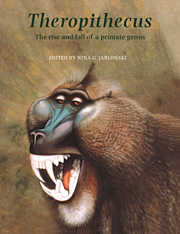Book contents
- Frontmatter
- Contents
- List of Contributors
- Preface
- Acknowledgements
- 1 Introduction
- PART I Fossil evidence and phylogeny
- PART II Biogeography and evolutionary biology
- PART III Anatomy of the fossil and living species of Theropithecus
- 10 Allometric aspects of skull morphology in Theropithecus
- 11 Evolution of the masticatory apparatus in Theropithecus
- 12 Dental microwear and diet in extant and extinct Theropithecus: preliminary analyses
- 13 The development and microstructure of the dentition of Theropithecus
- 14 Postcranial anatomy of extant and extinct species of Theropithecus
- PART IV Behaviour and ecology of living and fossil species of Theropithecus
- Appendix I A partial catalogue of fossil remains of Theropithecus
- Appendix II Conservation status of the gelada
- Index
14 - Postcranial anatomy of extant and extinct species of Theropithecus
Published online by Cambridge University Press: 11 November 2009
- Frontmatter
- Contents
- List of Contributors
- Preface
- Acknowledgements
- 1 Introduction
- PART I Fossil evidence and phylogeny
- PART II Biogeography and evolutionary biology
- PART III Anatomy of the fossil and living species of Theropithecus
- 10 Allometric aspects of skull morphology in Theropithecus
- 11 Evolution of the masticatory apparatus in Theropithecus
- 12 Dental microwear and diet in extant and extinct Theropithecus: preliminary analyses
- 13 The development and microstructure of the dentition of Theropithecus
- 14 Postcranial anatomy of extant and extinct species of Theropithecus
- PART IV Behaviour and ecology of living and fossil species of Theropithecus
- Appendix I A partial catalogue of fossil remains of Theropithecus
- Appendix II Conservation status of the gelada
- Index
Summary
Summary
In this study, the postcrania of Theropithecus gelada, T. oswaldi, T. brumpti, and T. darti were examined and compared to extant Old World monkey postcrania in order to present a morphological description of these elements for the genus, and for each species.
Functional analysis of the postcrania was provided to explain morphological differences between species.
The locomotor behaviour of each species was discussed.
The phylogenetic implications of morphological variation within the genus was addressed.
Comparisons with extant cercopithecoids show that extant and extinct Theropithecus possess a unique suite of characters on their postcrania that are related to locomotor and feeding behaviours, and that these characters appear early in the evolution of the genus.
Theropithecus gelada manually graze grasses, seeds, and rhizomes sitting upright most of the day plucking food items with their thumb and index finger. They ‘shuffle forward bipedally’ to move to new sites. Although geladas are terrestrial quadrupeds, these behaviours produce detectable characters in the shoulder, elbow, hand, and hip regions.
Theropithecus oswaldi, although two or three times larger in size, is very similar in morphology to T. gelada, indicating similar feeding and locomotor patterns.
In contrast, Theropithecus brumpti possesses a suite of characters in its shoulder, elbow and hip joints more indicative of an arboreal quadruped, suggesting the species was better adapted to arboreal habitats.
Theropithecus darti postcrania, although known only from one site, are more similar in morphology to T. gelada and T. oswaldi than to T. brumpti, indicating closer phylogenetic ties to the former two species.
- Type
- Chapter
- Information
- TheropithecusThe Rise and Fall of a Primate Genus, pp. 383 - 422Publisher: Cambridge University PressPrint publication year: 1993
- 19
- Cited by



